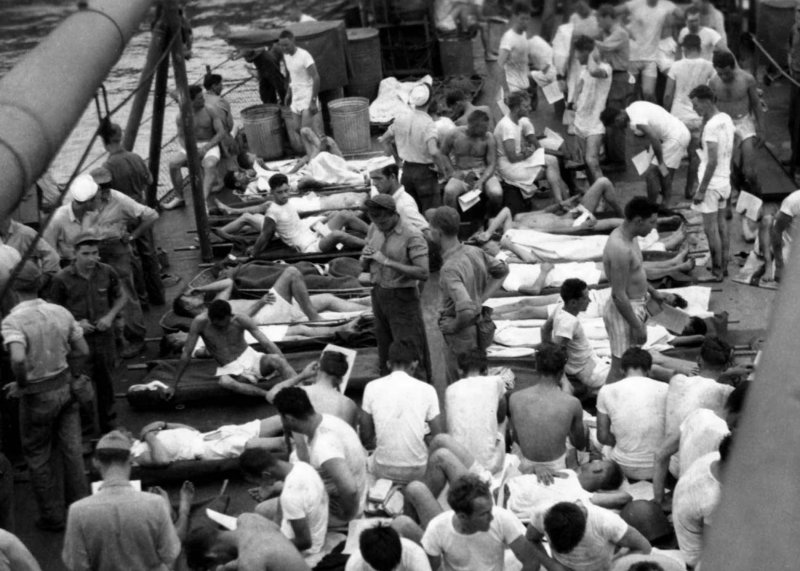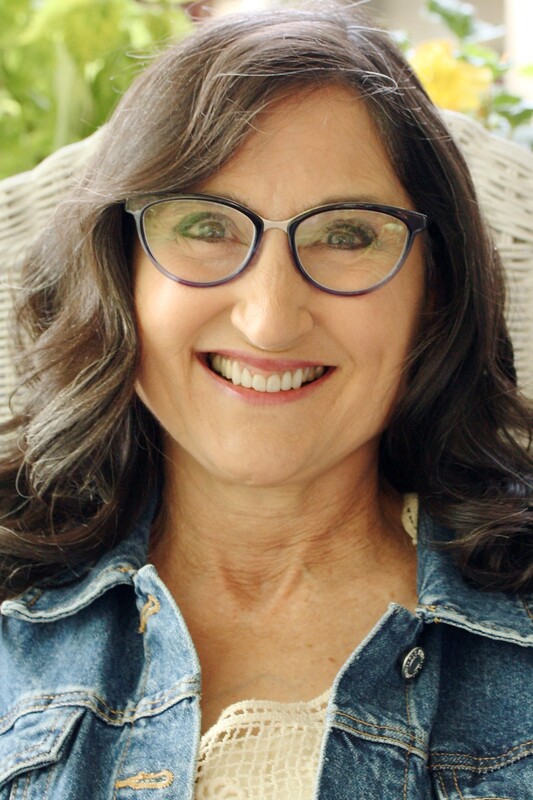|
The story of the USS Indianapolis was not pretty. Sunk by the Japanese at the close of WWII, only a quarter of her crew survived. Her captain was court-martialed and killed himself, possibly to escape the shame. Then in 1997, a sixth grader, Hunter Scott, interviewed survivors of the disaster for the school history fair. He thought they were heroes and that their captain got a bum deal. His project won the school fair, the country fair and then lost the state fair to a rock collection. But the boy believed in his project and continued his research, as well as his efforts to tell the true story of USS Indianapolis. The historical relevance of the ship was assured because of its secret mission, transporting the atomic bomb to the Mariana Islands in prep for the bombing of Hiroshima. As it turns out, that is but a footnote in the nearly unbelievable tale of this ship and men who sailed aboard her. 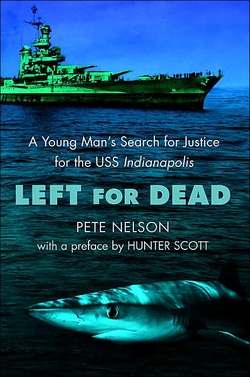 I learned about it in the book Left for Dead: A Young Man’s Search for Justice for the USS Indianapolis by Pete Nelson. The book combines the story of the survivors of the U.S. Navy's worst loss of life on a single ship with the story of Hunter Scott crusade to bring them the honor they deserved. After delivering the bomb, the Indianapolis set a leisurely course to the Philippines for some gunnery practice. The Indy was a cruiser, without the heavy armor of a battleship. At this point in the war, most of the fighting had moved to the far eastern Pacific closer to Japan, so the ship sailed without an escort. Though Japanese submarines had been sited earlier on the route, that information was classified and Captain Charles B. McVay wasn’t told. 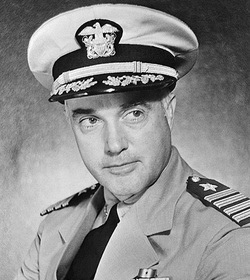 Captain Charles B. McVay Captain Charles B. McVay It late July, a mere 12-degrees from the equator, as the ship sailed through the muggy heat, air-ducts, water-tight doors and hatches were opened to cool the lower decks. Still, many sailors carried their blankets topside and found a space to catch the breeze and get some sleep. Shortly before midnight on July 29, a Japanese submarine surfaced, and the captain, looking through his binoculars saw a black dot on the horizon. He thought it was fate, for as he watched, the moon come out of the clouds right behind the ship. Silhouetted on the vast dark ocean, the Indianapolis sailed straight toward him. He gave the order to dive, and then to fire. At 12:02 the first torpedo hit, ripping off the front starboard corner of the Indianapolis and igniting a tank of highly volatile aviation fuel. Seconds later, two more explosions rocked the ship. Bulkheads collapsed, the ship took on water and the engines drove the Indy down. It took only twelve minutes to sink. About 300 men died outright or went down with the ship; 880 were thrown into the sea. They huddled together in groups and tried to stay afloat in the oil-slick, shark-infested waters. Some were burned or otherwise injured; many had no life-jackets. The worst-off got to rest in life rafts, safe from the sharks. But there had only been time to cut loose a few of the rafts and there were too few survival provisions for the number of men in the water. One of the radio operators encouraged those around him, telling how he had sent out the SOS and their location. They must simply hang on until rescuers arrived. Nelson goes into detail about the horrors the men faced as they waited. The burned and bleeding, those with broken limbs and dazed from concussions were the first to die. Daylight brought sunburn and thirst and no rescue. The second day brought dehydration, hunger and nasty disputes. The third day brought hallucinations, and loss of the will to live. Every day the sharks came. They swam in circles around the groups of men. Without warning a man would scream, then disappear into the deep. Men went out of their minds. The United States Navy did not even know the Indianapolis was missing. It would be more than 50-years before the Navy discovered that the SOS message had been received by four different people. Hunter Scott discovered that in each case, it had been ignored. On the fourth day after the ship sank, survivors were sighted by chance, and planes and boats headed to the area to save them. The last of the 317 men alive was picked out of the ocean on the fifth day. 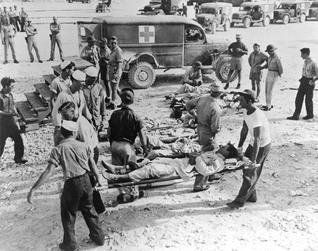 Survivors arriving on Guam after rescue. Survivors arriving on Guam after rescue. The Navy needed a scapegoat for this disaster and court-martialed the captain for not ordering a zig-zag course to avoid enemy torpedoes. The surviving men knew their captain was not to blame, and tried in vain for years to clear his name. Then in 1997, 11-year-old Hunter Scott heard Indianapolis disaster mentioned in the movie Jaws and decided to interview survivors for his history fair project. That set him on a course of friendship with the men and finally the exoneration of Captain McVay. I recommend this book because it's an important story that honors the survivors of the USS Indianapolis.There are recommend this book for two things the author does very well. One is the way he describes the science of how the human body reacts when deprived of drinking water while suspended in salt water. The second is his explanation of Post-Traumatic Stress Disorder as it was suffered by the survivors of the Indianapolis, and how, when in 1960, the men began to gather and talk about what had happened they began to heal. That healing was also helped in 2001 when, after Hunter Scott took their case to Congress, the crew of the Indianapolis were finally awarded a Navy Unit Citation. Comments are closed.
|
I'm fascinated to discover little-known history, stories of people and events that provide a new perspective on why and how things happened, new voices that haven't been heard, insight into how the past brought us here today, and how it might guide us to a better future.
I also post here about my books and feature other authors and their books on compelling and important historical topics. Occasionally, I share what makes me happy, pictures of my garden, recipes I've made, events I've attended, people I've met. I'm always happy to hear from readers in the blog comments, by email or social media. Archives
September 2023
Categories
All
|
